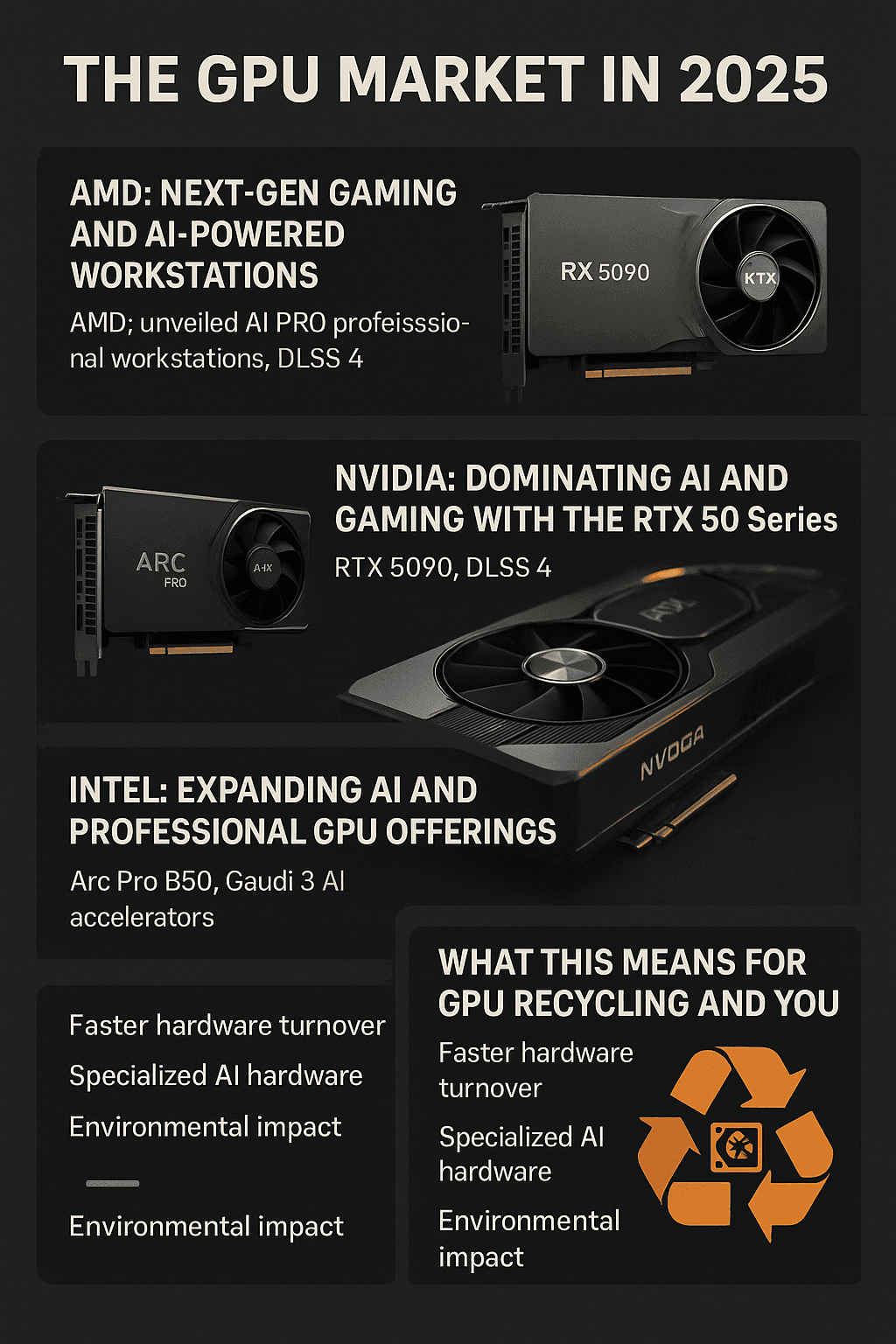The 2025 GPU Landscape: What AMD, Nvidia, and Intel’s Latest Innovations Mean for You

GPU Recycling
June 12, 2025

The GPU market is evolving rapidly in 2025, with AMD, Nvidia, and Intel pushing the boundaries of performance, AI capabilities, and workstation power. Whether you’re a gamer, professional, or involved in GPU recycling, understanding these developments can help you make smarter decisions about upgrading, repurposing, or recycling your hardware.
AMD: Next-Gen Gaming and AI-Powered Workstations
At Computex 2025, AMD unveiled the Radeon RX 9060 XT aimed at mainstream gamers, featuring next-gen gaming experiences and FidelityFX Super Resolution 4 (FSR 4) — a machine learning-powered upscaling technology that competes with Nvidia’s DLSS15. For professionals, AMD launched the Radeon AI PRO R9700 graphics card and the Ryzen Threadripper 9000 Series processors, designed to deliver exceptional performance in content creation, AI development, and high-end desktop workloads1.
In addition, AMD revealed its Instinct MI350 Series GPUs for AI and high-performance computing, offering a 4x generational leap in AI compute and a 35x increase in inferencing performance. These GPUs are already powering hyperscale deployments like Oracle Cloud Infrastructure and will be part of AMD’s upcoming “Helios” AI rack system, expected to deliver up to 10x more inference power2.
Nvidia: Dominating AI and Gaming with the RTX 50 Series
Nvidia remains the market leader with its RTX 50 Series GPUs based on the new Blackwell architecture. The flagship RTX 5090 delivers up to twice the performance of its predecessor and features DLSS 4 technology, which uses AI to generate multiple frames per rendered frame, boosting gaming performance by up to 8x6. Nvidia also integrates AI directly into shaders with RTX Neural Shaders, enabling real-time rendering of lifelike digital humans and environments — a breakthrough for gaming and virtual production6.
Beyond gaming, Nvidia is building Europe’s fastest exascale supercomputer, Jupiter, powered by its Grace Hopper platform, and is developing an industrial AI cloud with 10,000 GPUs to accelerate manufacturing and design for automotive giants like BMW and Volvo8.
Intel: Expanding AI and Professional GPU Offerings
Intel is making strides with its new Arc Pro B50 and B60 GPUs for workstations and AI inference, expanding the Arc Pro family with more memory and software support4. Intel also launched Gaudi 3 AI accelerators available in PCIe and rack-scale configurations, enabling scalable AI inferencing for enterprises of all sizes4.
At Computex 2025, Intel showcased its Core Ultra H and HX processors targeting high-performance gaming laptops, alongside improvements in AI inference capabilities through updated XMX cores in its GPUs6. Intel’s AI Assistant Builder, now publicly available, allows developers to create custom AI agents optimized for Intel platforms4.
What This Means for GPU Recycling and You
- Faster Hardware Turnover: The rapid release of powerful AI-focused GPUs means older models will enter the secondary market faster, increasing opportunities for GPU recycling and refurbishment.
- Specialized AI Hardware: New AI accelerators and rack-scale systems may require specialized recycling processes due to their unique design and cooling requirements.
- Environmental Impact: Responsible recycling is critical to recover valuable materials and reduce e-waste as GPU deployments expand in gaming, AI, and data centers.
At gpurecycling.com, we stay updated on these trends to help you responsibly recycle or trade in your GPUs, maximizing value while supporting sustainability.
Stay tuned for more insights on how to navigate the evolving GPU market and make the most of your hardware investments.